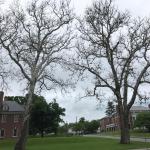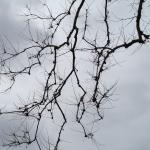Sycamore Anthracnose
Pathogen
The fungal pathogen Apiognomonia veneta (previously known as Discula platani) is responsible for sycamore anthracnose (Sogonov et al. 2007).
Hosts
Apiognomonia veneta occurs throughout the northern hempishere on Platanus species. In North America, sycamore (Platanus occidentalis) can be highly susceptible to the disease but natural resistance varies. While also susceptible to infection, London planetree (P. × acerifolia) often exhibits good disease resistance while Oriental planetree (P. orientalis) is also considered resistant (Sinclair and Lyon 2005, Sogonov et al. 2007). Infections on non-Platanus hosts are believed to be rare.
Symptoms & Disease Cycle
The most common symptom of sycamore anthracnose is the slow development or inability of sycamore to leaf out in the spring. Typically, this is associated with wet spring weather, which facilitates spore dispersal and infection of newly developing shoots and leaves. Even minor rain events (e.g. <0.3″) can be enough to promote disease development. Despite regular infection and, during certain years, high disease severity, trees are usually able to flush new growth once conditions become warmer and drier. Visible symptoms include angular leaf spots and blotches on the foliage (especially along the midrib), shoot and bud blight, and longitudinal cankers on twigs and small branches. In fact, the characteristic right-angle branching pattern typical of American sycamore is the result of repeated anthracnose infections. The terminal bud is killed, allowing the lateral buds to flush, creating the irregular branching pattern (Sinclair and Lyon 2005).
There are three distinct but often overlapping stages of sycamore anthracnose: (i) dormant twig/branch cankering and bud blight; (ii) shoot blight; and (iii) foliar blight. The fungus is active in twigs and branches during mild weather when the tree is dormant in autumn, winter and early spring. Active fungal growth within one-year-old twigs kills the tips, leading to bud blight. In addition, the fungus often grows into older branches below the dead twigs, creating perennial cankers. During wet spring weather, fruiting structures mature in discarded leaves from the previous season and in the bark of blighted twigs and cankered branches to disperse spores via wind and rain splash. These spores infect emerging shoots and developing leaves, which rapidly wilt and die. Because of the pathogen’s ability to overwinter in twig and branch cankers, it can readily produce spores that easily infect newly developing tissues nearby in the canopy (Sinclair and Lyon 2005).
Management
As a native pathogen of sycamore, anthracnose is often not a major threat to the overall health of the tree. However, in conjuntion with common stresses that occur in the managed landscape (e.g. soil compaction, restricted root zone, mechanical injuries, air pollution, drought stress), anthracnose can be a contributing factor to decline. Anthracnose fungi, like most foliar disease pathogens, require free moisture on the plant surfaces to infect. Canopy thinning that increase air flow and sunlight penetration can help to inhibit the pathogen by accelerating the drying of foliage after rain. Remove fallen leaves and prune infected twigs and branches, if possible, to reduce inoculum in the canopy. For large and mature trees, pruning of blighted twigs and cankered branches is not practical because the pathogen is so abundant in the canopy. On sites where sycamore anthracnose has been a chronic issue, planting resistant cultivars of London and Oriental planetree is recommended.
In southern New England, sycamores that have very sparse canopies due to anthracnose in early June are often able to flush a relatively full canopy by early July under normal disease conditions. Therefore, a "bad year" is typically gauged by how trees appear by early July. Years with very high disease severity can result in sycamores with sparse canopies lasting into early August. In general, chemical control for sycamore anthracnose is only warranted in select cases. For example, young trees suffering from transplant shock, repeated insect attack, other diseases, or site related stresses. Preventative applications should be applied at bud break and on labeled intervals until foliage is fully expanded or dry weather prevails. Injections of systemic fungicides can also be performed for more thorough distribution in the canopy, especially when twig and branch cankers are abundant. The following chemicals are labeled for use in landscape settings: copper hydroxide, copper hydroxide + mancozeb, copper salts of fatty and/or rosin acids, copper sulfate, debacarb + carbendazim, mancozeb, propiconazole and thiabendazole hypophosphite.
Citations
Sinclair WA and Lyon HH. 2005. Diseases of Trees and Shrubs, 2nd edn. Cornell University Press, Ithaca, NY.
Sogonov MV, Castlebury LA, Rossman AY, and White JF. 2007. The type species of Apiognomonia, A. veneta, with its Discula anamorph is distinct from A. errabunda. Mycological Research, 111(6) 693-709. https://doi.org/10.1016/j.mycres.2007.03.013.



